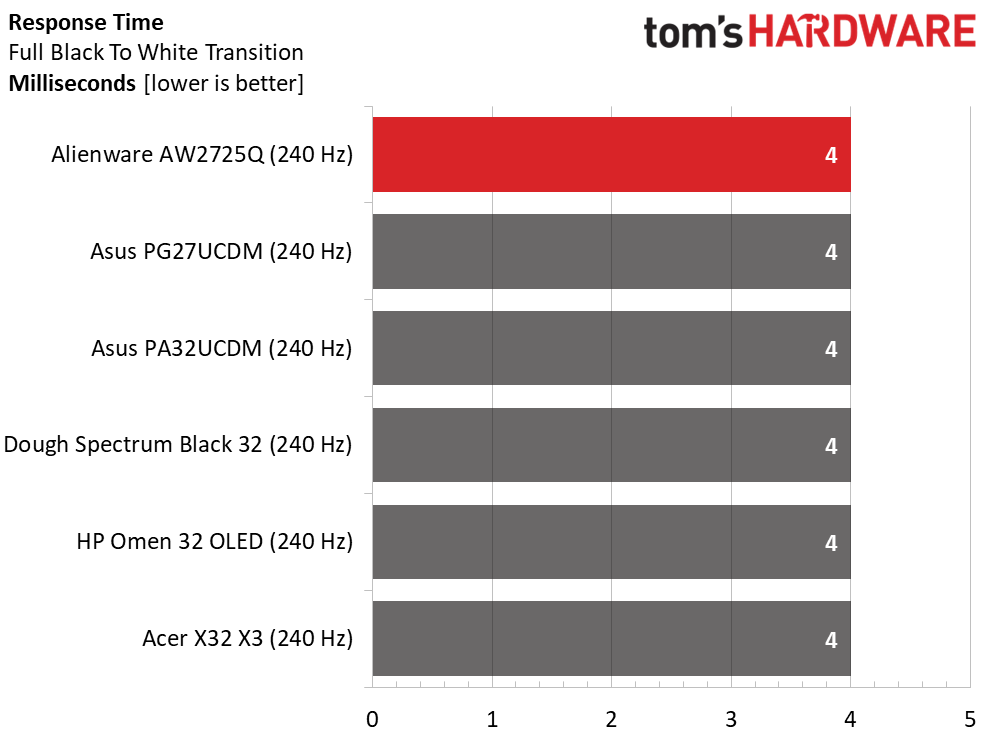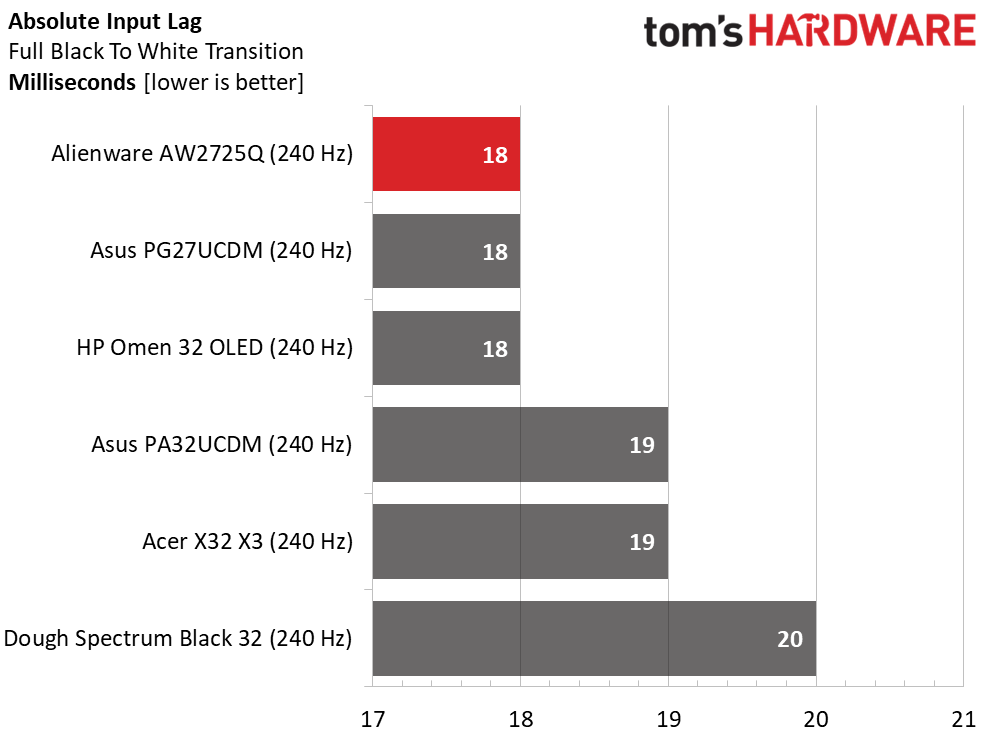Why you can trust Tom's Hardware
To compare the AW2725Q, I went with all 4K 240 Hz screens. Most of these are 32 inches, but I was able to include the 27-inch Asus PG27UCDM, which I recently reviewed. The others are Asus’ PA32UCDM, Dough’s Spectrum Black 32, HP’s Omen 32 OLED, and Acer’s X32 X3.
Pixel Response and Input Lag
Click here to read up on our pixel response and input lag testing procedures.


Comparing OLED’s motion resolution is difficult because all screens refreshing at a given rate will look identical. There is no overdrive or backlight strobe quality to judge. Every OLED refreshes the same way, so here at 240 Hz, they are equal by measure and when observed visually. Whether looking at test patterns or content, there is no change in resolution when objects or backgrounds are in motion. 4ms is what a 240 Hz OLED screen will score regardless of resolution. The AW2725Q has no black frame insertion available.
Input lag differences are tiny as well. The fastest panels are still in the QHD category, but 4K isn’t far behind, with all screens ranging from the AW2725Q’s 18ms to the Dough’s 20. You won’t perceive a difference here when gaming. All these monitors are competition-ready and will satisfy players of all skill levels. OLED is still the best gaming display tech, and no member of the group is deficient.
Test Takeaway: The AW2725Q ties the HP Omen 32 OLED and Asus PG27UCDM for the fastest 4K OLED monitor at 18ms of total control lag. That’s quick by any standard, from casual gamer to seasoned competitor. Smooth motion resolution keeps the action clear, no matter how fast it goes by. If you want a faster monitor, you’ll have to go with a QHD example like Philips’ 360 Hz 27M2N8500. For 4K gaming though, there’s none better.
Viewing Angles

I’ve observed that most QD-OLEDs exhibit a slight color shift at 45 degrees to the sides, which I call the “QD tint.” The AW2725Q has a subtle green tone in the above photo. It’s hard to spot in a test pattern, and its effect on content is negligible. There is no change to gamma or light output, so detail remains consistent. The top view appears slightly red and exhibits a lighter gamma.
Screen Uniformity
To learn how we measure screen uniformity, click here.

The AW2725Q is made from a very high-quality panel, which in my test had no visible anomalies and nearly broke the record in my database. 1.52% is about as low as it can possibly get for a nine-zone measurement. This is excellent performance from premium quality control.
MORE: Best Gaming Monitors
MORE: How We Test PC Monitors
MORE: How to Buy a PC Monitor
Current page: Response, Input Lag, Viewing Angles and Uniformity
Prev Page Features and Specifications Next Page Brightness and Contrast
Christian Eberle is a Contributing Editor for Tom's Hardware US. He's a veteran reviewer of A/V equipment, specializing in monitors. Christian began his obsession with tech when he built his first PC in 1991, a 286 running DOS 3.0 at a blazing 12MHz. In 2006, he undertook training from the Imaging Science Foundation in video calibration and testing and thus started a passion for precise imaging that persists to this day. He is also a professional musician with a degree from the New England Conservatory as a classical bassoonist which he used to good effect as a performer with the West Point Army Band from 1987 to 2013. He enjoys watching movies and listening to high-end audio in his custom-built home theater and can be seen riding trails near his home on a race-ready ICE VTX recumbent trike. Christian enjoys the endless summer in Florida where he lives with his wife and Chihuahua and plays with orchestras around the state.
-
MoxNix Way too expensive for what's a relatively slow refresh rate these days. The Alienware 27 inch 360 Hz 1440p monitor is a far better value.Reply -
mihen For Oled, refresh isn't a question of if the panel can do it. It's a question if the cable can do it. It's a 2160p verse 1440p difference.Reply
